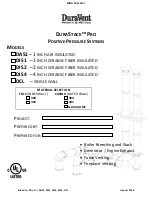
14
S
UBMITTAL
R
ECORD
FOR
D
URA
S
TACK
M
ODELS
DCL,
DAS1,
DIS1,
DIS2
AND
DIS4
M&G
D
URA
V
ENT
|
10
J
UPITER
L
ANE
|
A
LBANY
,
N
EW
Y
ORK
www.duravent.com
SECTION E – GUIDELINE FOR LOCATION OF
SUPPORTS
Supports can be used in different combinations to secure the
duct in place.
ADJUSTABLE, VARIABLE and BELLOW LENGTH
To prevent the LA, LV or LB from sagging, it is recommended
that the chimney section adjacent to the LA, LV or LB is
supported or guided.
When necessary, properly guide an adjustable length (LA) by
installing a Heavy Duty Wall Guide (WGHD) or any support
immediately below the chimney joint on the adjacent section.
TEE SUPPORT
The Tees must be properly supported to protect them from
bending forces. It can be done by means of an Anchor Plate
(AP), Anchor Plate Length (APL) or Heavy Duty Wall Support
(WSHD). When a Tee is used at the base of the vertical
riser, the preferred location for the support is above the Tee,
thus suspending the Tee.
ELBOW SUPPORT
Elbows are to be supported on one end with either an Anchor Plate
(AP), an Anchor Plate Length (APL) or a Heavy Duty Wall Support
(WSHD).
THROUGH FLOOR / CEILING SUPPORT
Supports for chimney that penetrate a non-combustible floor are to
be positioned on the top side of the floor. Include supports as per
the height limits in Table 3 and use either an Anchor Plate (AP) or
an Anchor Plate Length (APL) installed above structural framing
members.
THROUGH WALL SUPPORT
Chimney that penetrates a wall should be supported on both side
of the penetration. It can be supported by bracing with a Half
Angle Ring (HAR), an Anchor Plate (AP) or an Anchor Plate Length
(APL).
SECTION F – ROOF PENETRATION and FLASHINGS
Flashing (F)
The flat Roof Flashing (F) is used in conjunction with Storm Collar
(SC) for weatherization on a flat roof.
Figure 39 – Flat Roof Flashing (F)
Storm Collar (SC)
The storm collar is installed above the opening of the flashing and
clamps to the outside of the vent. The top of the storm collar
should be sealed using S-375
Figure 40 – Storm Collar (SC)
Adjustable Flashing (F30)
The Adjustable Flashing (F30) is used in conjunction with Storm
Collar (SC) for weatherization on a flat roof with a 5 degree to 30
degree pitch.
Figure 41 – Adjustable Flashing (F30)
GUYING AND BRACING
1. Proper guying and bracing is essential for part of the Chimney that
extends above the roof or parapet wall. The grease duct at this point is
subject to wind conditions and needs special attention for proper
stabilization.
2. If the chimney above the roof does not exceed dimension H, no special
guying or bracing is required. However, to protect the flashing from lateral
movement, a guide must be installed at the roof level.
3. For chimney height above the roof that needs guying or bracing, a
support, a small length and a expansion length must be installed near the
roof level to absorb the thermal expansion and minimize this effect on the
guy wires or brace.
4. When using guy wire, the cable must be slightly slack or loose to allow
thermal expansion.
5. When using rigid bracing, the maximum vertical height between
supports must be reduced to 5’ to compensate thermal expansion.
Guy Section details and cable attachments
Seal
at
vent
with
S
‐
375


































